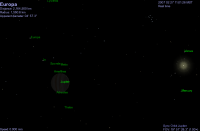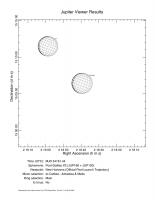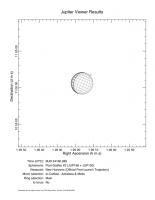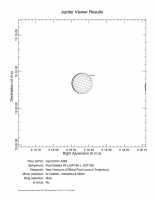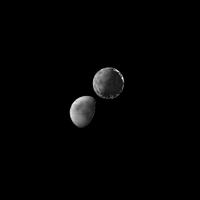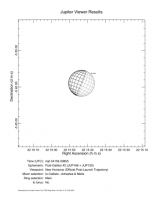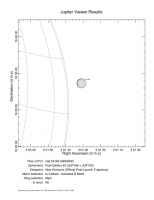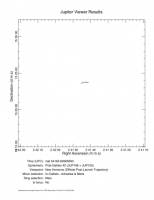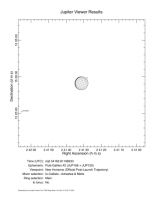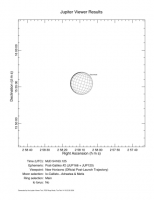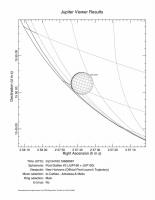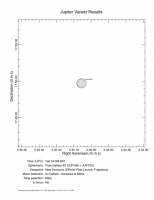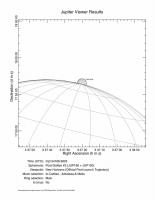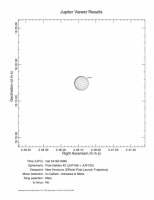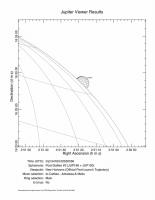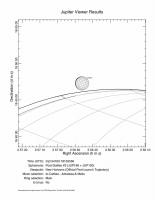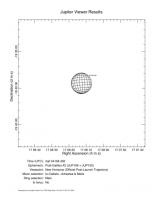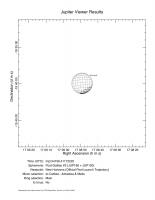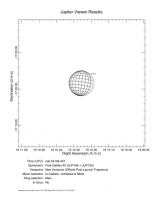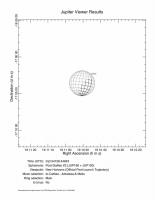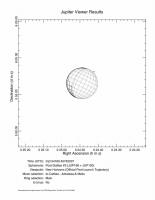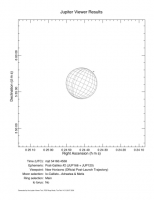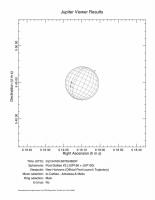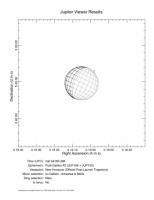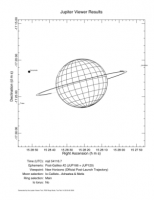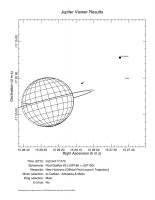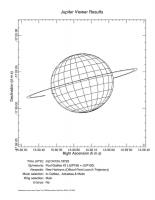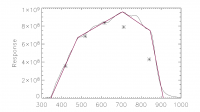Printable Version of Topic
Click here to view this topic in its original format
Unmanned Spaceflight.com _ New Horizons _ NH at Jupiter
Posted by: john_s Jan 22 2006, 10:57 PM
I think the Jupiter encounter deserves its own thread.
I've just been taking a first look at the Jupiter encounter geometry. You can do the same using Mark Showalter's excellent http://pds-rings.seti.org/tools/#newhorizons at the PDS rings node, which by good fortune happens to include a New Horizons ephemeris (calculated over a year ago) for our actual launch date, January 19th. We'll have an updated ephemeris soon, but this one's already good enough for planning. As Roby72 noted in the http://www.unmannedspaceflight.com/index.php?showtopic=2079&view=findpost&p=37685, the satellites are (annoyingly) all on the opposite side of Jupiter at closest approach. We'll still get good views of all sides of Io because Io rotates in only 1.8 days and we'll be pretty close to Jupiter for that long. We'll get fairly good coverage on Europa too, for the same reason. But we won't get very close to Ganymede or Callisto. Luckily Io is our highest priority satellite target and Europa is next, so we'll do OK.
Posted by: David Jan 22 2006, 11:16 PM
I think it does too, but couldn't it go under, well, http://www.unmannedspaceflight.com/index.php?showforum=48?
Posted by: john_s Jan 23 2006, 12:00 AM
Nah, IMHO New Horizons discussions should stay under the New Horizons topic.
John.
Posted by: Roby72 Jan 23 2006, 12:28 AM
John,
yes the day before (or after), Io must be on the right side of the planet, but I think the high speed of NH makes the distance about equal than on encounter day at the other side (about 2.5 Mio km). Resolution for LORRI (bw imager) should be about 12 km, for RALPH (color) about 50km) This would be nice for plume searching and is about 5 times more resolution in case of LORRI than Cassini had at its Jupiter encounter in Dec. 2000.
Robert
Posted by: ljk4-1 Jan 23 2006, 12:44 AM
Any chance NH could image Europa well enough to see if any surface features have changed/moved since Galileo?
Posted by: john_s Jan 23 2006, 01:40 AM
We'll be looking at Europa but not specifically for that purpose- our images will be far lower resolution than Voyager's and no changes were seen between Voyager and Galileo even at Voyager resolution, and over a longer timespan than between Galileo and NH. Our main goal in imaging Europa will be to look at the peculiar large, shallow, depressions that were seen by Galileo near the terminator- it's one area where we can improve over Galileo. Plus we'll be observing Europa's auroral emissions in Jupiter eclipse.
By the way, here's a table I just sent to the science team, showing the timing and geometry of various significant events during the encounter. Times are spacecraft times, and the numbers will change just a bit once we get a final ephemeris. I've only calculated the times of the eclipses of each satellite that occur closest to the spacecraft- there are many more at greater ranges. "UT" means Universal Time, "mrad" means the angular diameter in milliradians, and "Sub-S/C Lon" means the sub-spacecraft longitude. I couldn't figure out how to align the columns properly without replacing all the spaces with underscores...
---------------------------------------------------------------------------
____________________Range___Diam__Solar__Sub-
____Date_______UT___(km)___(mrad)_Phase_S/C_Lon__Event
---------------------------------------------------------------------------
February_25__09:45_6334186__0.831___11____349____Ganymede eclipse ingress
February_25__11:45_6222615__0.846___12____352____Ganymede eclipse egress
February_27__10:46_3074450__1.021___40____315____Europa eclipse ingress
February_27__13:18_3045261__1.030___45____321____Europa eclipse egress
February_27__14:20_2734370__1.331___48____303____Io Eclipse ingress
February_27__16:28_2758131__1.320___53____316____Io Eclipse egress
February_28__02:00_2957815__1.061___72____347____Europa closest approach
February_28__05:00_2304575_61.920___82___________Jupiter closest approach
February_28__06:00_3029556__1.737__102_____41____Ganymede closestapproach
February_28__06:30_4153289__1.156___81____353____Callisto closest approach
February_28__22:00_2260221__1.610__118____141____Io_closest approach
___March__1__08:48_2748816__1.324__120____231____Io_eclipse ingress
___March__1__10:58_2951842__1.233__121____248____Io_eclipse ingress
---------------------------------------------------------------------------
John.
Posted by: ljk4-1 Jan 23 2006, 05:16 PM
John.
Thank you for the information, John. Would New Horizons be able to look for any possible geysers from Europa as well? Might be good practice for similar events in the Pluto system, too.
Posted by: stevesliva Jan 23 2006, 10:56 PM
Especially if Triton is supposed to be a lot like Pluto.
Posted by: Sunspot Jan 23 2006, 11:50 PM
How many days/weeks before closest approach will New Horizons start imaging Jupiter? ![]()
Posted by: AlexBlackwell Jan 23 2006, 11:55 PM
I've just been taking a first look at the Jupiter encounter geometry.
Posted by: BruceMoomaw Jan 24 2006, 02:11 AM
Judging from the NH Jupiter encounter planning meeting I attended back at the 2003 DPS meeting, the most interesting piece of new information that comes out of the NH Jupiter flyby may be its near-IR spectra of the surface composition of the Galilean moons -- especially Europa. Its spectrometer has much higher spectral resolution than Galileo's and will be considerably closer to the Galilean moons that Cassini's, implying that it may be able to nail down whether that stuff mixed with Europa's ice is Mg sulfate or sulfuric acid.
Posted by: john_s Jan 24 2006, 09:45 PM
We typically get a couple of pixels on Himalia, similar to Cassini, though I haven't seen the geometry for the actual trajectory yet. Anyway, don't expect anything too dramatic on any outer satellties.
Posted by: Bart Jan 25 2006, 12:11 AM
On an extremely amateur basis, I did some (very) back of the envelope calculations and came up with Himalia spanning about 9.5 pixels a week after Jupiter C/A - slightly better than Cassini.
Can't wait to hear real numbers from people who actually know in a couple of weeks.
Bart
Posted by: Steffen Jan 26 2006, 07:26 AM
So New Horizons will take images of the Gas giant Jupiter and some of its moons?
Wondered if the lenses on the cameras are closed afterwards as some kind of protection and opened before Pluto encounter? ![]()
Posted by: ljk4-1 Jan 26 2006, 05:57 PM
* ASTRONOTES: Derelict Booster to Beat Pluto Probe to Jupiter
http://www.space.com/astronotes/astronotes.html
NASA's Pluto-bound New Horizons spacecraft now speeding through the Solar System
is set to reach Jupiter on Feb. 28, 2007, but it will not be the first craft of
its mission to reach the gas giant, mission officials said this week.
Posted by: MahFL Jan 26 2006, 06:09 PM
I think the lens cover on LORRI is designed just to open, its better to have a bit of dust on the lens than having a lens cover stick in the closed position.
Posted by: PhilCo126 Jan 27 2006, 06:00 PM
Don't know about covers on the NH lenses but I guess that by February 2007, the spacecraft's rotation will be stopped and will operate in 3-axis stabilisation mode.
( Remember Dr Alan Stern confirmed that NH can operate in both spin-stabilisation for cruise phase and in 3-axis stabilisation mode for encounter phases which will allow correct instrument pointing ).
Between Jupiter and Pluto, NH will probably go back into spin ? ![]()
Posted by: Decepticon Jan 28 2006, 08:41 PM
Does anyone know what Voyager/Galileo images will be comparable to the Horizons?
I'm trying to get a idea of what to expect.
Also will we get enough Jupiter imaging to create Voyager approach type movies?
Posted by: Bob Shaw Jan 28 2006, 11:36 PM
I'm trying to get a idea of what to expect.
Also will we get enough Jupiter imaging to create Voyager approach type movies?
My impression from what I've read so far is that NH isn't set up to obtain close-up imaging data from the illuminated portion of Jupiter and it's satellites, but will do well in 'Jupiter-shine' images of the satellites. Remember that NH is designed to explore a dark, dark place, rather than one that's just a bit dim!
Bob Shaw
Posted by: john_s Feb 5 2006, 05:22 PM
Bob Shaw
Actually, we've just figured out that we can probably take unsaturated daytime images with our telephoto camera (LORRI), though we won't know for sure until we can do some tests in flight. So we hope to get some nice B/W dayside images of the satellites after all. We're still stuck with dayside saturation in our color camera, MVIC, though, so our only color images of Io will be taken in Jupiter shine, and will thus (obviously) cover only the Jupiter-facing hemisphere.
Here's a simulation of some of our best views of the four Galileans, from LORRI (highest resolution), MVIC (color, though only B/W in this simulation, and saturated on most of the daysides), and LEISA (where every pixel represents a 1.2 - 2.5 micron near-infrared spectrum). The geometry is pretty accurate. I've brightened up the nightside of Io so you can see what volcanos might be glowing in the dark there.
Posted by: icez Feb 5 2006, 05:43 PM
Here is Celestia's view of Io and Europa--relative to Jupiter and the Sun on the time of the Jupiter encounter. It "looks" like there could be some moonshine going on from what I see.
Posted by: ugordan Feb 5 2006, 06:07 PM
That's very nice to hear, but I'm curious how you suddenly came to that conclusion?
That's awesome! I see the LORRI images are slightly blurred, did you actually go through the trouble of simulating the camera's PSF as well?
Posted by: john_s Feb 5 2006, 06:59 PM
That's awesome! I see the LORRI images are slightly blurred, did you actually go through the trouble of simulating the camera's PSF as well?
Now the spacecraft is launched we have time to think of creative ways to use the instruments. The problem with LORRI was that it has no shutter, so light falls on the CCD during the readout phase, producing a smeared image. If the exposure is shorter than the readout time, as needed to avoid saturation on the Galileans, the "readout smear" can be brighter than the image itself, and can be difficult to remove. What we just figured out is that for the special case of a small target against black sky there's a fairly easy way to remove the readout smear, even if we can't remove the smear from, for instance, a short-exposure closeup image of Jupiter's clouds.
And yes, I included a very crude estimate of the LORRI PSF in those simulations. Well spotted!
Posted by: JRehling Feb 5 2006, 07:06 PM
Is moonshine bright enough to help you out there? Io will experience a pretty full Europa late on Feb 27 and into Feb 28 (UTC), which by my crude math would be as bright as a magnitude -11 in the ionian sky. During that interval, Io would wane from gibbous as seen from NH, leaving a crescent in europashine; to crescent in the sunshine leaving a gibbous swath in europashine. During the same interval, Jupiter would go from a sliver to a full disk as seen from Io, so Europa may end up illuminating a small segment only for NH's benefit, but that's something? If having too much light is a problem, does europashine result in not enough?
Posted by: john_s Feb 5 2006, 07:27 PM
Interesting thought- we'll check into it, though my gut feeling is that moonshine won't be bright enough to be useful. Galileo took some cool images of Jupiter's clouds in Io-shine, but they were very long exposures and fairly smeared.
'
Posted by: Bob Shaw Feb 5 2006, 07:49 PM
'
Perhaps the combination of the two light sources may be a winner - Jupitershine and light reflected by the moons.
Good luck!
Bob Shaw
Posted by: Decepticon Feb 5 2006, 07:59 PM
Thanks for those samples!
I can't wait!!! ![]()
Posted by: JRehling Feb 5 2006, 08:12 PM
Good luck!
Bob Shaw
There'll also be a pretty full Callisto in the ionian sky, but that would contribute much less light than Europa.
Posted by: tty Feb 5 2006, 09:27 PM
Is there any plans for imaging the night side of Jupiter? There might be some interesting things to see there for a high-sensitivity camera (auroras, thunderstorms, meteorite impacts....).
tty
Posted by: Comga Feb 6 2006, 05:17 AM
The doors on LORRI and Ralph both open with one-time, spring loaded mechanisms. These devices are well proven and have high reliability, as almost anything is better than having the door stick in the closed position, as you said.
We will know for sure in a few months. Does anyone know when they plan to open the doors and take test images?
Posted by: tasp Feb 6 2006, 03:47 PM
We will know for sure in a few months. Does anyone know when they plan to open the doors and take test images?
I am sure there is a good reason for not doing this, but I have always wondered why these ejectable lens covers aren't made of lexan.
If they don't come off, camera would still work.
Must be missin' sumpthin' ?
Posted by: djellison Feb 6 2006, 03:52 PM
Well - consider the MER MI cover - that's an orange filter - so even if the cover's shut, you can still see something.
I'd imagine using something like lexan or other transparant materials for a thermal cover of an instrument has potential for a lot of problems with being britle, heavier, bad thermal properties, perhaps outgassing and contaminating optics etc etc....
And as Alan's said a few times, better is the enemy of good enough.
Doug
Posted by: ljk4-1 Feb 6 2006, 03:57 PM
Jupiter wouldn't be so bright that it could burn out NH's cameras, could it?
Posted by: john_s Feb 6 2006, 04:57 PM
Nope, the New Horizons CCDs, like most CCDs, are very resistant to burnout.
Posted by: RNeuhaus Feb 6 2006, 07:28 PM
Here is the snapshot when NH is around the closest distance from Jupiter at February 28, 2007, 05:00 am.
http://space.jpl.nasa.gov/cgi-bin/wspace?tbody=599&vbody=-98&month=3&day=1&year=2007&hour=22&minute=00&rfov=20&fovmul=-1&bfov=10&porbs=1&showsc=1
Jupiter: 2.306 millions km
IO : around 2.664 millions km Closer
Europe: 2.967 millions km
Ganymede: 3.020 millions km
Calixto: 4,160 millions km
These above predicted distance might change after the next TCM.
Rodolfo
Posted by: volcanopele Feb 6 2006, 08:28 PM
Here's a simulation of some of our best views of the four Galileans, from LORRI (highest resolution), MVIC (color, though only B/W in this simulation, and saturated on most of the daysides), and LEISA (where every pixel represents a 1.2 - 2.5 micron near-infrared spectrum). The geometry is pretty accurate. I've brightened up the nightside of Io so you can see what volcanos might be glowing in the dark there.
what is the wavelength range for LORRI? Does it extend at all into the near-IR? would be interesting to see how active Pele (or Pillan 10 years after its big eruption) is when Io is in eclipse.
Remember John, there is no need to image any of the other moons, just focus on Io
Posted by: BruceMoomaw Feb 6 2006, 08:47 PM
Pfaw. The most important thing NH will do at Jupiter is get near-IR spectra of the Galilean moons' surface compositions far better than any obtained by either Galileo or Cassini -- maybe good enough to settle the question of what the non-ice component of Europa's surface really is.
Posted by: john_s Feb 6 2006, 08:51 PM
Remember John, there is no need to image any of the other moons, just focus on Io
LORRI extends to 1 micron wavelength so we may see some volcanic thermal emission on the nightside, as we will with MVIC, and with LEISA of course. We should get a nice data set on the hot spots! Plumes, too...
Posted by: ljk4-1 Feb 6 2006, 08:52 PM
Can NH look for any plumes from Europa as well?
Posted by: Decepticon Feb 7 2006, 01:37 PM
Funny you miss spelled Europa Io
Posted by: john_s Feb 7 2006, 03:38 PM
Maybe you folks can help us...
We're now starting to lay out the timeline for the Jupiter encounter, but what we haven't done so far is look for "Kodak moments" as the Cassini imaging folks call them- times when we have scenic alignments or unusual geometries that call for a picture that's motivated by beauty more than science. Anyone want to help us find these moments?
Mark Showalter has now updated his http://pds-rings.seti.org/tools/#newhorizons to include the actual spacecraft trajectory through the Jupiter system. So you can download a table of satellite positions as seen from the spacecraft, and see views from the spacecraft of any body in the system at any time. It's probably most efficient to use the "Jupiter Ephemeris Generator" tool to create a table first and use that to find possible interesting alignments (e.g. times when the RA and Dec offsets of two satellites are similar), and then use the "Jupiter Viewer" to check out the view from the spacecraft at that time. The field of view of LORRI, our greyscale telephoto camera, is 5 x 5 milliradians, or 1044 arcseconds (parameters for all instruments are http://www.pluto.jhuapl.edu/spacecraft/instruments.html). Make sure that you are using the "Official Post-Launch" trajectory option, which is the default.
If you find a specific time when you think we should press the shutter, let us know! No guarantees that we'll be able to do so, as there are numerous conflicts and constraints, but we'll give it a try. LORRI images don't take a lot of resources so we can probably spare a few for scenic purposes. MVIC color images are more "expensive", and are likely to have partial saturation except at high phase angles, so we're less likely to use MVIC for this purpose.
Thanks!
John.
Posted by: djellison Feb 7 2006, 03:51 PM
The very easiest way for this is if someone can get it into celestia, and we can just run thru the flyby looking for interesting moment ![]()
You've opened a big bad can of worms here John ![]() Downlink was 2048kbps from Jupiter wasnt it
Downlink was 2048kbps from Jupiter wasnt it ![]()
I'm sure you'll have lots of loonie ideas - but a moon rising or setting from behind Jupiter with possible refraction thru the upper atmosphere could be interesting....
Not sure of exact timing (see attached) if I have the night-side-day-side right, this would see a crecent Io set behind the dark-limb of Jupiter, so it would be squished and squashed as it set, in a way a little similar to this...
http://spaceflight.nasa.gov/gallery/images/shuttle/sts-103/html/s103e5037.html but without a bright limb of Jupiter to get 'in the way'
Some upper atmosphere refraction has been seen by Cassini...
http://ciclops.org/media/dr/2005/1114_2631_2.png
http://ciclops.org/media/dr/2005/1191_2857_2.png
http://ciclops.org/media/dr/2005/1017_2487_1.jpg
Perhaps something to be learnt about the properties and extent of the upper jovian atmosphere by catching this little event?
I think that the classic Cassini 'mutual' events of transits etc are likely to be uncommon at a range worth imaging (guessing here).
Another potential target that's perhaps half scientific, half Kodak - is a lit side of a moon, being partially occulted by the jovian ring system- not sure how it might look or if it would appear at all, but again, potential for something 'interesting' if not beautiful ![]()
Doug
Posted by: hendric Feb 7 2006, 08:33 PM
I created a spreadsheet and imported the ephermis for a few weeks around closest approach, for every 20 minutes in the enounter. Best one so far is:
MJD Objects Notes
54161.44 IO & EUROPA Really close pass
Try adding a few hundredths of a MJD either way. When using the Jupiter Viewer, enter MJD as MJD 545161.44.
There are a few others from further away. I want to redo the ephermis +- a day to closest approach to see if I am missing any due to the 20 minute step size.
I'll post the spreadsheet once I'm done, promise!
Posted by: hendric Feb 7 2006, 11:17 PM
OK, so there were a few additional close Io and Amalthea passes. Looking at the graphs, the majority of passes are Io & Amalthea, with a few others, mostly with Amalthea. The speedy little moon gets around! ![]()
MJD Bodies Comments
54149.68056 IO & AMALTHEA Europa is just out of view to the NW, good view of the rings
54149.8888 IO & AMALTHEA Thebe is left of Amalthea, IO is pretty far away
54150.98611 IO & EUROPA Far pass
54157.925 IO & JUPITER Io grazes the north side of jupiter, leaving J disk on dark side
54158.943 IO & JUPITER Io goes behind jupiter on the dark side
54159.365 EUROPA & JUPITER Europa grazes the southern dark side of Jupiter
54160.12 IO & JUPITER Crescent IO in front of dark side Jupiter, emerges few minutes later
54160.12 AMALTHEA & JUPITER Crescent Amalthea in front of dark side of Jupiter, emerges a few minutes later
54161.042 IO & JUPITER Io disappers behind jupiter on the dark side, with the rings visible and in shadow. Encounter with Io and Rings starts earlier
54161.43646 IO & EUROPA Really close pass!!! ![]()
54161.85 EUROPA & AMALTHEA Rings are between them
54161.97083 IO & AMALTHEA Rings are between them, with Adrastea possible
54162.85365 IO & AMALTHEA Close pass, rings and Metis visible, long encounter!
54165.125 IO & EUROPA Small crescents for both
54165.70833 IO & AMALTHEA Rings & jupiter, but distance function shows a bump, so could be interesting encounter
54168.70833 IO & EUROPA Pretty far pass, but in the same field
54170.94633 IO & EUROPA Amalthea emerges from behind Jupiter, might make an interesting appearance, all objects showing thin crescents
I had to do a manual search for Jupiter events, and gave up after a bit.
Unfortunately, the spreadsheet is over 20 MB, so I can't post the full thing. Here is a PDF of the charts, and a cut-down spreadsheet that you can enter the data in yourself. Some notes:
1. You have to modify the RA so that it is monotonic. What does that mean? When scrolling down, if you get to a set of entries that go from +~24 to ~0, then you need to change the RA(corr) column to (RA+24) to keep it linear.
2. RA is multiplied by 15, to get something vaguely representing degrees.
Any other questions, or if you want the full spreadsheet, feel free to ask.
Posted by: hendric Feb 7 2006, 11:19 PM
Here's the reduced spreadsheet.
Posted by: Bart Feb 8 2006, 01:44 AM
Any word yet on the possibility of imaging Himalia?
Bart
Posted by: mcaplinger Feb 8 2006, 03:07 AM
Lexan isn't a good choice due to outgassing and optical quality. It's fairly hard to make a cover that doesn't screw up optical performance, especially for a fixed-focus system.
That said, the Galileo SSI did have a transparent cover (I'm guessing it was glass). All of the systems I've worked on (MOC 1&2, THEMIS, CTX, MARCI 98&05) had no covers at all -- we were too mass-constrained.
Posted by: ljk4-1 Feb 8 2006, 12:20 PM
That said, the Galileo SSI did have a transparent cover (I'm guessing it was glass). All of the systems I've worked on (MOC 1&2, THEMIS, CTX, MARCI 98&05) had covers at all -- we were too mass-constrained.
If only they had been as thoughtful with the antenna on Galileo.
Could they have put Galileo into orbit around Europa? Or was the radiation just too much for the probe towards the end of its life?
Posted by: djellison Feb 8 2006, 12:24 PM
Did you mean to say 'no covers at all' ?
As thinking back to imagery from the KSC gallery - I certainly dont remember any covers on the instruments you mention.
Doug
(PS - Galileo was basically knackered - electronics exposed to huge ammounts of radiation - and certainly not enough fuel to go into Europan orbit - the reason for crashing it into Jupiter as I understand it was that they didnt expect to have enough fuel for manouvering on board to keep control of the vehicle, and they wanted to dispose of it whilst still in control of it.)
Posted by: ugordan Feb 8 2006, 12:34 PM
As someone already said, unfolfing HGAs were used numerous times before, with no difficulties unfolding. It was a proven concept. What got Galileo in the end was all that trucking around the country, waiting to be launched literally for years.
That's an even worse situation than trying to put Cassini into orbit around Titan. There's just too much delta-V needed for it to be anywhere near feasible. Galileo was "running on fumes" at the end of its life with practically no propellant left.
It also wasn't really designed to stand up to prolonged heavy radiation doses a Europa orbit would guarantee so that scenario wouldn't work in real life.
Posted by: dvandorn Feb 8 2006, 02:22 PM
And, the final nail in the Europa-orbit coffin was that Galileo wasn't completely sterilized (although you'd think that the Jovian radiation belts would have finished *that* job*), and there was a perceived contamination risk if it were to crash onto Europa. The easiest and most certain way to make sure that never happened was to ensure that Galileo was destroyed well away from Europa -- hence it was flown to its destruction into Jupiter itself.
-the other Doug
Posted by: JRehling Feb 8 2006, 04:31 PM
Could they have put Galileo into orbit around Europa? Or was the radiation just too much for the probe towards the end of its life?
A qualitative guide to delta-v calculations:
Let's use an object at infinity (from, say, Jupiter) as the baseline. Zero energy.
The next thing is to put it into a very distant orbit. That's one step away from zero.
Then put it into an orbit with a distant apojove but a decently close perijove. That's a big energy step from the last one. It's also the easiest science orbit to achieve. Almost all orbiters of all other planets have been in that category, besides the ones that have used aerobreaking to help. By the way, the energy is proportional to the mass of the object, so it's about 3000 times more delta-v at Jupiter than Mars.
Then it's a big step to pull in that apojove. Roughly 20% of escape velocity. That's what it would have taken to get Galileo into a jovian orbit near Europa.
At that point, stop thinking about Jupiter and consider getting the thing at infinity for Europa, and bring it down in the same steps (much easier, because of Europa's lower mass).
Basically, that 20% of Jupiter's escape velocity is a killer.
Posted by: john_s Feb 9 2006, 05:54 PM
Just a quick note to say thanks, hendric, for all your work on this- I haven't had a chance to look at the details yet but I'll do so soon.
John.
Posted by: tedstryk Feb 9 2006, 10:43 PM
One thing I remember reading in the early 1990s, before the stuck antenna problem was known, is that the idea of ending the mission with a Ranger-like kamikazee into Io. That would have been cool, but of course with the antenna being stuck, there was no way to transmit the data from such an even.
Posted by: Rob Pinnegar Feb 10 2006, 01:12 AM
Yeah, straight into one of the calderas and *SPLASH*!
Posted by: BruceMoomaw Feb 10 2006, 02:50 AM
Last but hardly least, Europa was the one place they didn't want it to crash, due to the risk of biocontamination -- and any orbit around a Galilean moon decays after very long, due to the tidal influence of Jupiter itself. Since there is also some slight biological interest in Ganymede and Callisto, they decided from the very start to finish up by crashing it into either Io or Jupiter -- and the latter is a teensy bit easier to hit. So...
Posted by: Comga Feb 10 2006, 04:50 AM
What would happen if you tried to take color images with MVIC and looked at the Methane band? It is pretty narrow, so the signal level is much lower. While you might get back three bands of saturated images, this one might be usable. The question then would be if it would be USEFUL and worthwhile.
Posted by: tedstryk Feb 10 2006, 11:16 AM
I remember seeing an article about New Horizons possibly being able to encounter an outer moon, such the mention of Himalia earlier, should one be located serendipitously in the right area. Now that NH is on its way, as anyone looked into any possibilities?
Ted
Posted by: BruceMoomaw Feb 10 2006, 02:28 PM
That subject has been discussed earlier in this very thread. Alas, NH (despite Alan Stern's earlier hopes, as repeatedly expressed to me) will be considerably farther from Himalia than Cassini was, and won't be anywhere near any of the other irregular satellites either -- nor will it come anywhere near a Centaur (another of his long-shot hopes).
Posted by: Rob Pinnegar Feb 10 2006, 03:09 PM
Geez, that's too bad.
This really serves to drive home the point that Jupiter's (Hill) sphere of influence is enormous. There are something like fifty of those "outer gravel" satellites known, and we won't be getting close to *any* of them? They're spread pretty thin.
We're not completely dead yet, though. There's still a year to go before the Jupiter encounter. If we're really lucky, someone will find another one of those little buggers right close to New Horizons' path. Granted, this would pretty much take a miracle, but it's always possible.
[Edit: We might have a bit more luck with a targeted search for Centaurs, though... could it be done?]
Posted by: tedstryk Feb 10 2006, 06:52 PM
I think my question was unclear. I was referring to a possible telescopic search to see if anything small is lurking near NH's path, similar to what will be done for the Kuiper Belt.
Posted by: JRehling Feb 10 2006, 07:12 PM
This really serves to drive home the point that Jupiter's (Hill) sphere of influence is enormous. There are something like fifty of those "outer gravel" satellites known, and we won't be getting close to *any* of them? They're spread pretty thin.
With orbital radii of about 12.5m km, we could think of it as a big circle with a diameter of 25m km that NH is passing through twice. It's actually quite unlikely that you'd come within 1m km of any of 50 of them -- this isn't bad luck, it's the way this game is set up.
Additionally, the satellites have common orbits (in various subgroups) so the probability of an equatorial flyby hitting one of their orbits is not modeled by 50 independent events. If a group crosses the jovian equatorial plane at what is currently Jupiter-leading or Jupiter trailing, then of course a close Jupiter flyby would have no chance of coming near any such body. Given enough random Jupiter flybys, we'll probably see the great majority (over 80-90%) fail to image any outer satellite, then maybe one such flyby will image two or three of them. Although the radial angle alone gives many many ways for an encounter NOT to happen!
Imagine if instead of putting a deorbit module on HST, we instead moved it to a distant Jupiter orbit (2 or 3x Callisto's orbital radius at perijove) while it still had some life left. We'd get Galileolike coverage of the inner system all the time, and we would eventually get some great images of the outer satellites! Of course, HST weighs about 4.5 times as much as Galileo did...
Posted by: TritonAntares Feb 10 2006, 10:04 PM
No smaller Jupiter satellite or any Centaur near NH-Track... ![]()
...but what about an asteroid between Mars and Jupiter?
Any chance of passing one in 'nearer' vicinity;
this means having better resolution than from Earth?
Bye
Posted by: Bart Feb 10 2006, 10:11 PM
TritonAntares: Check out post #3 in "New Horizons in the Asteroid Belt"
Unfortunately, the answer is no.
Bart
Posted by: hendric Feb 14 2006, 05:56 PM
John,
How quickly can LORRI cycle between pictures? Also, do you expect you'll be able to capture Jupiter's faint rings? What about if a moon is in the same FoV?
Posted by: hendric Feb 14 2006, 06:38 PM
How quickly can LORRI cycle between pictures? Also, do you expect you'll be able to capture Jupiter's faint rings? What about if a moon is in the same FoV?
Here's an ani gif of the IO + RINGS + JUPITER encounter. I didn't notice before, but it looks like Metis is also visible, but I don't think it will be more than a pixel or two. The pictures are taken 5 minutes apart.
BTW, since Io passes behind Jupiter's dark side, it should be illuminated well by the Jupiter-shine.
Posted by: john_s Feb 14 2006, 07:19 PM
Pretty cool animation- we can certainly take pictures fast enough to make a movie like that, though the rings are probably much fainter than the illuminated crescent of Io so I'm not sure if we can get a good exposure on both Io and the rings at the same time. This is one that we'll consider if there turns out to be room in the timeline.
Posted by: hendric Feb 14 2006, 07:48 PM
Here's an animation of the Europa/Io encounter. Both are crescents, which should be perfect for LORRI's sensitivity. The frames are taken 90 seconds apart. I'm not sure where they are relative to Jupiter, so they may or may not be getting any Jupiter-shine. Would LORRI be able to take a picture just from starshine?
I also made a what-if picture, taking John's simulated pictures and rotating/rescaling them to fit, with the image rescaled to fit into 1024x1024 at 1044 arcseconds. It's Not Real Life, But It's Pretty Close ™ ![]()
I just checked, and it looks like some bad news. ![]() Europa probably will NOT be in Jupiter-shine. Io might still have some. There will still be visible crescents from both.
Europa probably will NOT be in Jupiter-shine. Io might still have some. There will still be visible crescents from both.
Posted by: hendric Feb 14 2006, 09:59 PM
A few more animations.
First is of a half-lit Europa going behind the extreme southern end of Jupiter's dark side. Europa's dark side will be lit partially in Jupiter-shine.
Second is another Europa going behind dark Jupiter, from further away, and later in the flyby. Europa is a slim crescent. Could NH search for plumes at Europa while it is a crescent, or while most of the bright slice is hidden behind Jupiter's dark side?
Timestep is 90s for both.
Posted by: hendric Feb 14 2006, 11:53 PM
Two views of the same encounter. One is centered on Amalthea, one is centered on Io (for those Io fanatics...hint hint Jason ![]() ) The Io centered one follows Io until it disappears behind Jupiter. Should be well lit in Jupiter-shine. Metis is also visible. Timestep is 6 minutes.
) The Io centered one follows Io until it disappears behind Jupiter. Should be well lit in Jupiter-shine. Metis is also visible. Timestep is 6 minutes.
Posted by: hendric Feb 15 2006, 04:32 AM
Two Ganymede encounters.
1st is Ganymede passing in front of Jupiter. Timestep is 15 minutes. I have selected a KODAK_MMT (if you can only get one...) John, I hope your workaround for the bright parts of the moons will work on a crescent Jupiter!
2nd is Ganymede grazing the north side of Jupiter, lit up in Jupiter-shine. My KODAK_MMT is exactly when Jupiter and Ganymede's axe (Is that plural for axis?) line up. Should be a pretty photo. Timestep is 20 minutes.
The KODAK_MMTs are at full resolution, low filesize to give an idea of how they would fit as desktop background. ![]()
Posted by: tasp Feb 15 2006, 04:49 AM
IIRC, Galileo may have noted some 'debris' in the vicinity of Amalthea. I am aware that due to distance, NH cannot resolve Amalthea more than a few pixels, but should Amalthea be eclipsed or occulted (by Jupiter or another moon) perhaps we could confirm the 'mysterious' (to me) Galileo finding. A stepped change in brightness, or debris remaining visible longer than Amalthea itself might be an interesting thing to find out.
Posted by: john_s Feb 15 2006, 04:50 AM
1st is Ganymede passing in front of Jupiter. Timestep is 15 minutes. I have selected a KODAK_MMT (if you can only get one...) John, I hope your workaround for the bright parts of the moons will work on a crescent Jupiter!
2nd is Ganymede grazing the north side of Jupiter, lit up in Jupiter-shine. My KODAK_MMT is exactly when Jupiter and Ganymede's axe (Is that plural for axis?) line up. Should be a pretty photo. Timestep is 20 minutes.
The KODAK_MMTs are at full resolution, low filesize to give an idea of how they would fit as desktop background.
Those are awesome! I'll show the movies at the next team meeting, and I hope we can actually take one or two of them (or at least, some well-timed stills).
Thanks much,
John.
Posted by: hendric Feb 15 2006, 04:52 AM
Callisto/Jupiter encounter. Timestep is 25 minutes. Callisto, well lit in Jupiter-shine, passes completely behind Jupiter and back out again. There is quite a long time spent behind Jupiter, 3.4 hours, so it might be better to split this into an ingress/egress capture with shorter timesteps. I have selected some KODAK_MMTs from the entry and exit.
Posted by: hendric Feb 15 2006, 05:58 AM
Eclipse encounters. John, I assume you can't take pictures of shadow transits across Jupiter due to the brightness? What if Jupiter was far enough away that it only partially filled the CCD, a la your moon workaround? I think I'll do a shadow transit/GRS/moon transit search for when Jupiter fills the CCD from 20% to 80% on the way in.
I also am curious how large the penumbra is vs the umbra, and which John's application uses for its calculations. I guess since the Sun is so far away at that distance, the P vs U difference isn't that much? It still might be worthwhile to keep on Ganymede for a few extra shots after fully eclipsed because of this, and also refraction through Jupiter's atmosphere.
Ganymede and Europa ingress before closest approach. I didn't do egress, since it would look pretty similar.
Timestep is 2 minutes for Ganymede and 1 minute for Europa.
Io eclipse ingress and egress right after closest approach. This series is interesting, because we are seeing an eclipse from the side of a round ball instead of from the front. This causes the eclipse line to look rather odd, especially during egress. Also, Io is relatively large due to the time near closest approach.
Timestep is 20 seconds. Io really moves fast!
Sorry for the attachment ordering, I don't know what's going on.
Posted by: Stephen Feb 15 2006, 05:59 AM
Some years ago on one of the Usenet newsgroups one of the more informed members mentioned that some had contemplated a more spectacular end-of-mission for Galileo if only the antenna had not become stuck: a swan dive into Io a la Ranger.
"Waaaay back, in the early days of the mission, before the antenna failure,
a Ranger-style snapping-pictures-all-the-way-down kamikaze dive into Io
was seriously proposed as a possible way of terminating the mission, when
fuel ran low. Io was originally going to get only the one flyby, right at
arrival, and so a closer look would have been quite valuable. "---4:14 am, Sun, Feb 4 2001, Henry Spencer replying to Patrick Flannery
in "Galileo (spacecraft)" thread on sci.space.history newsgroup
(EDIT: just located an earlier version of the same info by the same author: July 5 1997 in the "Shut Down Probe" thread on the sci.space.history group.)
======
Stephen
Posted by: hendric Feb 15 2006, 05:59 AM
OK, now that's a little strange. I defintely posted that last message as two seperate messages to get under the 1MB attachment limit. But the BB keeps joining them back into one! Is this a feature of the upgrade?
Posted by: djellison Feb 15 2006, 08:29 AM
I'm still finding features but yes, I believe that's one of them. It tried to tidy up and not have one person making several consecutive replies.
Doug
Posted by: hendric Feb 15 2006, 08:56 AM
There are actually two double shadow transits that occur before the flyby! Here is the animation of the first one. The shadows are both on Jupiter between 54117.03611 and 54117.10833. I couldn't resist adding additional time before and after the transits to show Ganymede and Io zipping around Father Jupiter.
Animation starts at 54116.7 and ends at 54117.13750000. Timestep is 15 minutes.
My KODAK_MMT is the center of when both shadows are visible, and targeting Io so that Jupiter and Ganymede are both visible.
The second shadow transit begins at 54123.875 and ends 54124.275. There is a very short time from 54124.1875 to 54124.206944 that both shadows are visible at the same time (basically, 28 minutes). It's also likely that due to the geometry, NH would not be able to see one of the shadows. I don't have time to do a 50 step animation, so my KODAK_MMT is the midpoint of when both shadows are visible, 54124.19722.
John, it's been fun helping out. But now I have to get back to work!
Posted by: hendric Feb 20 2006, 04:59 AM
Will you be able to let us know which movies and KODAK_MMTs the team selects?
Also, I was hoping you could give us some technical details on your technique to recover the moon image data? I've got a solution:
The readout time is too long on the CCD, causing potential saturation at the lowest exposure times.
1. I assume you can take 0-s frames for measuring bias on the CCD?
2. What about moving the target up/down on the CCD to vary the amount of time for the average exposure? For example, if the CCD took 100 ms to readout, a 0-s exposure with an object at the middle of the frame would give an average exposure of 50ms. And as you move the object closer to the top, the exposure length would get shorter.
3. There would a small increase in brightness as you went down the rows, but so long as you're not totally saturated at the bottom you should be able to subtract out the increase since CCDs are linear.
This would even work to get photos of Jupiter, you would just have to take slices of it and mosaic the parts that don't get overexposed. Hopefully the inter-frame time isn't too long.
Of course, images with multiple bright objects far apart wouldn't be possible, unless the FoV could be rotated to get the objects near the top.
Posted by: ugordan Feb 20 2006, 08:53 AM
I think the problem John is trying to describe is image smear during readout phase, not because the exposures are too large.
They can select a short enough exposure which won't bleach out the moons, but that exposure is short compared to the readout phase. LORRI has no shutter so light falls on the CCD continually. As a result, while the image is being readout light from the moon is still coming in and the end result of this (CCDs readout one line at a time, shifting the entire image in the process until the last image line is shifted into the A/D converter) is what I imagine will be a good image of the target with sort of a vertical motion-blur effect overlaid on it.
That is the gist of the problem with imaging the Galileans -- removing the unwanted "motion-blur" effect. Obviously, the images will need to be carefully processed to remove this linear smear. What John Spencer seems to be saying is that they can actually subtract the blurred part, but only for a small, well-defined target such as a moon or Jupiter when it's still far away.
I can't wait to see the results, both from the imaging perspective and image processing perspective they should be interesting indeed.
Posted by: john_s Feb 20 2006, 03:35 PM
That is the gist of the problem with imaging the Galileans -- removing the unwanted "motion-blur" effect. Obviously, the images will need to be carefully processed to remove this linear smear. What John Spencer seems to be saying is that they can actually subtract the blurred part, but only for a small, well-defined target such as a moon or Jupiter when it's still far away.
That's exactly correct. For small targets (or, we think, for any image where we can arrange for a number of complete rows of dark sky in the field) we can probably get unsaturated images even at low phase angles, so we are interested in "Kodak moments" at low phase angles as well as high phase angles. And yes, we'll be sure to let you know which "Kodak" images make it into the final plan, though we won't know for a while, probably for several months. Integrating the Jupiter observations is pretty complicated (our biggest issue right now is finding the best times for the necessary Earth-pointed tracking periods, when we can't take data), and any "Kodak" observations will be the last things we add to the timeline, after we've optimized all our science observations.
John.
Posted by: hendric Feb 21 2006, 05:16 AM
Ah yes, I forgot that CCDs transfer the pixels down and then over. In that case you would get a vertical smear of the image. I assume what you're doing is something like this:
1. Simplified image is like this:
1: 0
2: 8000
3: 8000
4: 8000
5: 0
6: 0
2. Pixels are read out from the bottom of the display, with each row dropping down one during the readout. Each pixel read out step would be something like this, ideally:
0 -na- -na- -na- -na- -na- -na- -na-
1 0 -na- -na- -na- -na- -na- -na-
2 0 0 -na- -na- -na- -na- -na-
3 8000 0 0 -na- -na- -na- -na-
4 8000 8000 0 0 -na- -na- -na-
5 8000 8000 8000 0 0 -na- -na-
6 0 8000 8000 8000 0 0 -na-
Output row Read 0 Read 0 Read 8000 Read 8000 Read 8000 Read 0 Read 0
3. Since the readout time is comparable to the exposure time, and there is not a shutter, each time a value is in an "exposed" pixel, like 2-4 above, it would get a certain amount of light, depending on how long the value is kept in that pixel. For example, let's say 10% of the exposed value, so 800 in this case since all light pixels are 8000:
0 -na- -na- -na- -na- -na- -na- -na-
1 0 -na- -na- -na- -na- -na- -na-
2 800 800 -na- -na- -na- -na- -na-
3 8800 1600 1600 -na- -na- -na- -na-
4 8800 9600 2400 2400 -na- -na- -na-
5 8000 8800 9600 2400 2400 -na- -na-
6 0 8000 8800 9600 2400 2400 -na-
Output row Read 0 Read 0 Read 8000 Read 8800 Read 9600 Read 2400 Read 2400
4. Since you said above that you would need a few complete rows of dark in the image, I guess you are taking the value placed in those last image rows (in this case the 2400 read out in step 6&7) and using that to adjust the previous pixels? How do you subtract out the value, since it’s not going to be linear across real-world light pixels?
5. It should be possible to also do it based on the opposite direction, since you know how long you timed the exposure and what the readout time per line is, and CCDs are pretty much linear. IE, if you have a readout time of 100ms, and 1024 rows, then you would get an additional exposure of 100/1024 or 97us per light pixel on the way off the CCD. So if you took an image 10ms long, you know the first light pixel read out from each column has no extra light, with each following pixel having .097/10=.0097 or about ~1% additional light from each corrected light pixel ahead of it. With this method, you could take full-frame light images, even if the top of the frame is overexposed the lower portions should be recoverable.
PS
John, I now understand what your problem was wrt that table not keeping the correct spacing. Even if you mark a section as
0123456789012345
the editor doesn't switch to a fixed width font. What I did is edit my original table in Outlook with the font set to Courier New, and then copied&pasted it back here with the code tags.
PPS
Interestingly enough, I did some googling on this, and found out that the IRIS freeware camera software will automatically take care of this issue for you!
http://www.astrosurf.com/audine/English/result/obtu.htm
http://www.astrosurf.com/audine/English/first.htm#smearing
http://www.astrosurf.com/buil/iris/tutorial17/doc30_fr.htm#deconvflat
Well whaddaya know!
Posted by: john_s Feb 21 2006, 03:24 PM
^^^Your analysis is almost correct- the additional wrinkle (which I didn't realize myself till recently) is that there is an additional period of smeared exposure *before* the static image is exposed, which looks exactly the same as the readout smear but is in the opposite direction. The result is that all rows in the image, whether "above" or "below" the main target, have exactly the same amount of readout smear in them. This makes it easy to subtract the smear if you have any dark sky rows- you can measure the smear in the dark sky rows and subtract it from all the other rows. We don't yet know how well this will work in the real world (though we are optimistic), and we'll always have to content with the photon noise from the subtracted smear, which can be significant.
Posted by: stevesliva Mar 4 2006, 03:44 PM
I thought it might be hard to get excited about jovian cloud dynamics, but this definitely helps:
http://science.nasa.gov/headlines/y2006/02mar_redjr.htm
Perhaps Red Junior will still be there next year!
Posted by: Jyril Mar 4 2006, 03:52 PM
The spots from it formed existed for about 70 years, so I don't think it'll disappear really soon.
Posted by: AlexBlackwell Mar 9 2006, 09:55 PM
Pluto Mission News
March 9, 2006
http://pluto.jhuapl.edu
--------------------------------------------------------------------------------
New Horizons Adjusts Course Toward Jupiter
With a 76-second burst from its thrusters today, New Horizons cleaned up the last of the small trajectory “dispersions” from launch and set its course toward next February’s gravity-assist flyby of Jupiter.
Changing the spacecraft’s velocity by about 1.16 meters per second, the maneuver was the smallest of the three New Horizons has carried out since launch on Jan. 19, and the first conducted with the spacecraft in three-axis pointing mode. It also aimed New Horizons toward the Pluto “keyhole” at Jupiter – the precise point where the giant planet’s gravity helps swing the spacecraft toward the close flyby of the Pluto system on July 14, 2015.
When the maneuver started at noon EST, New Horizons was about 51.7 million kilometers (32.1 million miles) from Earth, moving along its trajectory at 37.5 kilometers (23.3 miles) per second. Mission operators at the Johns Hopkins University Applied Physics Laboratory in Laurel, Md., monitored spacecraft status through NASA’s Deep Space Network antenna station near Canberra, Australia.
Posted by: AlexBlackwell Mar 20 2006, 05:22 PM
The PI's Perspective
Zero G and I Feel Fine
March 20, 2006
http://pluto.jhuapl.edu/overview/piPerspectives/piPerspective_current.php
Posted by: hendric Mar 20 2006, 05:48 PM
John,
How much of a change to the Jupiter encounter with the TCM make? Will the simulator be adjusted with the new trajectory?
Posted by: john_s Mar 20 2006, 11:29 PM
How much of a change to the Jupiter encounter with the TCM make? Will the simulator be adjusted with the new trajectory?
At this stage in the game, the close approach time is being tweaked by a few minutes at most, and the distances are not changing significantly. Mark Showalter may update the trajectory in his Jupiter Viewer sometime, but you can rely on the simulator for most practical purposes.
John.
Posted by: Sunspot Mar 21 2006, 12:23 AM
Do you have a date for when you expect to start taking the very first Jupiter data? ![]()
Posted by: Alan Stern Mar 21 2006, 06:11 AM
We will begin the Jupiter data collect at the very beginning of Jan 2007. The exact date
will not be known for some months as we refine planning an negotiate DSN contacts
with JPL. If you want a best guess, put down Jan 10, with an error bar of +/-5 days.
And by the way, TCM-3 did not change our reference course through the system. It trimed out
residuals in our trajectory and put us closer to that exact reference course.
Posted by: AlexBlackwell Mar 30 2006, 01:41 AM
http://pluto.jhuapl.edu/news_center/news/032906.htm
Pluto Mission News
March 29, 2006
Posted by: BruceMoomaw Mar 30 2006, 02:49 AM
While the Europa Focus Group meeting suggested that New Horizons' near-IR spectra of Europa -- contrary to my fond hopes -- probably will not reveal any new substances mixed with Europa's ice, its long-range LORRI photography will try to directly display one fascinating new type of Europan terrain feature only recently revealed by Paul Schenk's stereo analysis of Galileo's photos.
These are "crop circles" -- gigantic structures that look like huge, gentle semicircular moats in Europa's surface, hundreds of km wide and dozens of km thick, which are too gentle to be directly revealed by surface shadows in any single images so far, and which (given our limited views of them so far) may actually be just parts of complete, huge ring-like structures. No one knows whether they're crater remnants, diapirs, or some other kind of structure in Europa's ice -- but NH will photograph Europa's terminator (something Galileo didn't do too much of) to try to get a clearer look at them. (These were among the very few genuinely new scientific revelations at the meeting.)
Posted by: mchan Mar 30 2006, 04:41 AM
Tried google and got Schenk's paper -
http://www.lpi.usra.edu/meetings/lpsc2005/pdf/2081.pdf
but the other links were just about as expected for a search on "cr*p c*rcles".
Posted by: BruceMoomaw Mar 30 2006, 06:22 PM
Good heavens. I completely overlooked that paper -- I was under the impression that their existence was first announced at this year's meeting!
Posted by: john_s Apr 2 2006, 03:54 PM
Actually the "crop circles" are seen better by near-terminator imaging than by stereo- it's the near-terminator imaging that we'll be concentrating on with New Horizons. They are indeed strange and wonderful features so I hope we can shed some more light on them (so to speak).
On another topic, we had a meeting last week where we thrashed out the details of the Jupiter encounter timeline- we now have a time-ordered listing of science observations, calibration observations, and DSN passes that seems to satisfy nearly all of our science goals. There will still be fine-tuning, but we finally have a pretty clear idea of what we'll be doing, and when. It feels like we've passed an important milestone.
It look's like we'll be able to include a few of Hendric's "Kodak Moments", too, though we haven't made any final decisions on which ones.
John.
Posted by: hendric Apr 3 2006, 08:40 PM
John.
Sweet! I hope you'll be able to get the one of Io and Europa passing by each other, and the ones with the moons grazing Jupiter's limb.
Posted by: john_s Apr 3 2006, 08:49 PM
So far, it looks like we should be able to do the conjunction of the crescents of Io and Europa at around 10:30 on March 2nd, and maybe one or two others. My personal favorite, the crescent Io about to be occulted by Jupiter, with the ring in front of it, from 01:00 on March 2nd, is unfortunately during some critical ring observations, but there's at least some chance that we'll be able to sneak it into the timeline (it *is* a ring observation, after all...). It's likely that we'll be doing stills, not movies- movies take too much data.
John.
Posted by: hendric Apr 4 2006, 05:32 AM
Will you be able to capture the double shadow transit? It occurs on January 17, 2007, well before the close encounter.
http://www.unmannedspaceflight.com/index.php?act=Attach&type=post&id=4076
Posted by: john_s Apr 4 2006, 06:01 PM
http://www.unmannedspaceflight.com/index.php?act=Attach&type=post&id=4076
I'll pass that idea along to the folks planning the "observatory phase" observations that we'll be doing at that time. Resolution won't be dramatically better than groundbased at that time, though.
Posted by: elakdawalla Apr 4 2006, 06:35 PM
Maybe not, but it would still be cool, and there's a lot to be said for that!
--Emily
Posted by: Bob Shaw Apr 4 2006, 06:54 PM
Here's a thought: if NH sees Jupiter from the side (a la Galileo and the SL-9 impact) then perhaps combined observations from Earth and NH will give us stereo pairs. If the spacecraft isn't otherwise engaged, a movie could be made of the event, in stereo - that'd be a good dry-run for NH's close encounter phase too!
Bob Shaw
Posted by: ljk4-1 Apr 4 2006, 07:36 PM
Any chance that NH might try to image Earth during its journey?
Posted by: hendric Apr 5 2006, 03:58 AM
But what are the chances that a professional groundbased telescope will be pointing at Jupiter for a shadow transit? On the other hand, it would allow for significant E/PO possibilities with schools, amateurs, etc.
And as others have said, there is something to be said for beauty and grandeur.
Posted by: john_s Apr 5 2006, 03:34 PM
Yes, we're all for beauty and grandeur! We'll try to cover the transit with NH. These days, of course, there are lots of amateurs who are getting Jupiter images as good or better than those from professional telescopes (e.g. see the http://www.ehu.es/iopw/jupiter_images.htm), so it's quite likely that the double shadow transit will be covered by amateurs somewhere, though Jupiter is fairly low in the pre-dawn sky in January 2007 and that will limit earth-based opportunities.
Posted by: Rakhir Apr 6 2006, 09:01 AM
NH will now soon pass Mars's orbit.
But unfortunately too far away from Mars to say a last good bye to all her friends who gathered at the big Mars party.
Does anyone know the time of the orbit crossing ?
-- Rakhir
Posted by: Alan Stern Apr 6 2006, 10:57 AM
But unfortunately too far away from Mars to say a last good bye to all her friends who gathered at the big Mars party.
Does anyone know the time of the orbit crossing ?
-- Rakhir
Rakhir--
The orbit crossing occurs very close to 10:00 UT on the 7th.
-Alan
Posted by: Toma B Apr 6 2006, 11:22 AM
Alan--
You should update "Passing The Planets" part of New Horizons site then...
Why don't you add all future planet orbit crossing dates when on the subject?
Posted by: Alan Stern Apr 6 2006, 11:59 AM
B)-->
Alan--
You should update "Passing The Planets" part of New Horizons site then...
Why don't you add all future planet orbit crossing dates when on the subject?
[/quote]
Nice idea. I'll have it implemented.
Posted by: Tom Tamlyn Apr 6 2006, 02:08 PM
I believe that LORRI, NH's high resolution camera, cannot be pointed towards the sun (and therefore not towards the earth either). It was designed for the shady haunts of Pluto, and would be damaged by bright light. In fact the lens cap won't come off until NH is near Jupiter, and even then, IIRC, LORRI won't be able to image the sunlit sides of Jupiter and its moons.
It would be interesting to know whether LORRI will ever be able safely to look back and take a http://www.solarviews.com/cap/misc/vgr_fam1.htm of the solar system the way Voyager did.
TTT
Posted by: ugordan Apr 6 2006, 02:21 PM
That's not true. See earlier posts in this thread. They will be able to take unsaturated images of Jupiter and the Galileans, but there'll be a smearing problem that can ideally be subtracted out. We'll have to wait and see how this works in real life. We actually might get some decent shots of the moons and Jupiter (though only when the latter is still far away, not filling the field of view, shots of the moons will be possible at all times as they'll never get that big).
Posted by: Alan Stern Apr 6 2006, 08:44 PM
[
Here are the preliminary orbit crossing dates for the outer planets closer than Pluto:
Jupiter: February 27, 2007
Saturn: June 8, 2008
Uranus: March 22, 2011
Neptune: August 29, 2014
After double checking these, we'll post them on the mission web site.
-Alan
Posted by: RNeuhaus Apr 6 2006, 08:48 PM
Jupiter: February 27, 2006
Jupiter: February 27, 2007 Not?
Rodolfo
Posted by: Alan Stern Apr 6 2006, 09:36 PM
Rodolfo
Of oourse. Corrected.
Posted by: punkboi Apr 6 2006, 10:39 PM
Here are the preliminary orbit crossing dates for the outer planets closer than Pluto:
Jupiter: February 27, 2007
Saturn: June 8, 2008
Uranus: March 22, 2011
Neptune: August 29, 2014
After double checking these, we'll post them on the mission web site.
-Alan
Awesome. How interesting that NH will take one year after the Jupiter flyby to reach Saturn, whereas it took Cassini four more years to reach Saturn after the Jovian flyby in 2000. Not to state the obvious.
Posted by: tedstryk Apr 7 2006, 12:34 AM
New Horizons doesn't have to break into orbit around Saturn, or any other planet. Hence, it can travel much faster.
Posted by: punkboi Apr 7 2006, 03:50 PM
I know. That's why I said I didn't mean to state the obvious.
Posted by: Planet X Apr 12 2006, 04:53 PM
Jupiter: February 27, 2007
Saturn: June 8, 2008
Uranus: March 22, 2011
Neptune: August 29, 2014
After double checking these, we'll post them on the mission web site.
-Alan
OK, I have a couple more orbit crossing questions to ask. First, when will New Horizons pass the orbit of Ceres, the largest asteroid? Also, when will New Horizons pass the orbit of 2003 UB313? Later!
J P
Posted by: Planet X May 11 2006, 09:06 PM
OK, I've answered my own question concerning when NH will pass Ceres. The spacecraft will cross the orbital path of Ceres on July 6, 2006. The actual passing of Ceres in heliocentric distance will take place on July 25, 2006 at 18:30 UTC due to Ceres being close to it's outermost possible distance from the sun. Indeed, the 3 AU crossing takes place just two days later on July 27, 2006! Later!
J P
Posted by: john_s Jun 29 2006, 04:16 PM
It's been a while since I gave an update on the Jupiter planning process. In the last three months the science team, and several other folks who are helping us out, have come up with a very detailed draft timeline for the Jupiter encounter. We just had a meeting at APL in Baltimore where we presented the plan to the spacecraft team who will now have the job of implementing it. This is where the dreams of the scientists meet the engineering realities, and we may need to scale back our ambitions a bit to make the plan more workable- we'll see how things go over the next few months.
In any case, the current version of the plan includes several of the "Kodak moments" identified by Hendric a few months ago- thanks again for your work on that! These include the double satellite shadow transits at 1/17/07 1:46 and 1/24/07 4:46; Europa emerging from behind Jupiter at 2/28/07 11:53; the conjunction of the crescents of Io and Europa at 3/2/07 10:29; crescent Ganymede crossing the crescent of Jupiter at 3/4/07 3:55; and Callisto emerging from behind Jupiter at 3/4/07 4:38. No guarantees that these will all survive the implementation process, but we'll try to make them all happen.
John.
Posted by: Bob Shaw Jun 29 2006, 04:29 PM
In any case, the current version of the plan includes several of the "Kodak moments" identified by Hendric a few months ago- thanks again for your work on that! These include the double satellite shadow transits at 1/17/07 1:46 and 1/24/07 4:46; Europa emerging from behind Jupiter at 2/28/07 11:53; the conjunction of the crescents of Io and Europa at 3/2/07 10:29; crescent Ganymede crossing the crescent of Jupiter at 3/4/07 3:55; and Callisto emerging from behind Jupiter at 3/4/07 4:38. No guarantees that these will all survive the implementation process, but we'll try to make them all happen.
John.
John:
I hope they get defined as 'Hendric Moments' in the mission planning!
Bob Shaw
Posted by: hendric Jun 29 2006, 07:47 PM
John,
Great news. I'm happy to have helped. Is there any chance of getting something of the eclipses?
http://www.unmannedspaceflight.com/index.php?showtopic=2088&st=74
I'd love to see what the moons look like once they're in eclipse; I imagine they get quite a bit of light refracted from around Jupiter. Besides, it's the one KODAK_MMT Cassini can't offer for some time, because of Saturn's tilt. ![]()
Posted by: john_s Jun 29 2006, 09:53 PM
We'll be taking a lot of observations of the satellites in eclipse for scientific reasons- no need for special "scenic" observations. We'll be looking for auroral emissions from their atmospheres, and for Io, we'll also be imaging the glow of its volcanos. See for instance http://photojournal.jpl.nasa.gov/catalog/PIA03450...
John.
Posted by: djellison Jun 29 2006, 10:01 PM
I was ploughing through some ACS / WFPC2 Jupiter observations, one sequence includes Ganymede appearing from behind the limb of Jupiter and there's little or none of the distortion I was thinking might be cool - but I have no doubt that some of these Hendrick moments will be cool - I really loved that Cassini move of Io's glowing voclanology ![]()
Doug
Posted by: john_s Aug 24 2006, 09:55 PM
Hi Folks-
I've just posted lots of details about the New Horizons Jupiter encounter plans http://www.boulder.swri.edu/~spencer/nhjupitersupport/. This page includes a llink to detailed PDF-format Powerpoint presentation that describes exactly what we plan to do, and when, though some details are likely to change, perhaps including some significant cutbacks, during the implementation process.
Enjoy!
John.
Posted by: punkboi Aug 24 2006, 09:59 PM
I've just posted lots of details about the New Horizons Jupiter encounter plans http://www.boulder.swri.edu/~spencer/nhjupitersupport/. This page includes a llink to detailed PDF-format Powerpoint presentation that describes exactly what we plan to do, and when, though some details are likely to change, perhaps including some significant cutbacks, during the implementation process.
Enjoy!
John.
John, can you tell us when the lens cover to LORRI will be opened? Thanks
Posted by: john_s Aug 24 2006, 10:02 PM
The LORRI lens cap will be opened in about a week, IIRC- we'll be taking some test pictures of Jupiter (only about 100 pixels across) shortly after the grand opening. We're all quite excited to see them...
Posted by: Decepticon Aug 24 2006, 10:14 PM
ME 2!!!
Posted by: ugordan Aug 24 2006, 10:17 PM
Indeed, we all are
John, right now I'm watching the simulated images of Io on page 13 and I'm wondering how prone is LORRI's CCD to that nasty charge bleeding effect? These exposures optimized for plume viewing seem problematic, also is the scattered light in the optics going to be a problem here?
Do you already have these effects characterized during ground testing or is this up to in-flight calibration?
Posted by: punkboi Aug 25 2006, 12:21 AM
Great, thanks John. Can't wait to see the test pics as well
Posted by: stevesliva Aug 25 2006, 05:27 PM
Awesome presentation -- thanks! Lots of ring science, and thankfully some nice Kodak moments.
Posted by: Julius Sep 16 2006, 09:09 AM
John S has seen the first pics from NH of Jupiter as stated in the planetary blog;I kindly ask him to put those first images on this site.Thanks
Posted by: john_s Sep 16 2006, 04:34 PM
Sorry folks- images will have to be released through the regular channels. The really good images, from LORRI, have been taken but not downlinked yet- we should have them on the ground next week. So please be patient a little longer. As I said before, at this range even the LORRI Jupiter images will not be spectacular, though it will sure be good to see them.
John.
Posted by: Phil Stooke Sep 17 2006, 02:40 AM
John, that was a great piece you did for the Planetary Society. Thanks! - both of them were good, I should say, but the one on this topic was particularly useful and informative.
Phil
Posted by: stevesliva Sep 18 2006, 07:59 PM
Thanks for the heads up, Phil! It is indeed great: http://www.planetary.org/blog/
I can't believe that NH is only the 8th spacecraft to Jupiter. Certainly it's such a valuably huge gravity well that I'd have expected more fly-bys. I guess only polar-solar spacecraft and those that are going farther out have taken advantage, though. Now with Galileo gone, I need to increase the regard in which I hold each fly-by.
Posted by: Decepticon Sep 19 2006, 02:06 AM
I enjoyed reading this... http://www.boulder.swri.edu/~spencer/nhjupitersupport/nhjupiterscience.pdf
Not bad! Tons of science to come. ![]()
Posted by: nprev Sep 19 2006, 03:48 AM
Wow!!! ![]() This is a considerably more ambitious Jovian system campaign than I'd anticipated...looks like it'll be almost as much fun as Voyager, in fact.
This is a considerably more ambitious Jovian system campaign than I'd anticipated...looks like it'll be almost as much fun as Voyager, in fact.
Hopefully, the MSM will pick up on this...lots of good missions still to be flown, and NASA/JPL needs to exploit every PR opportunity to make them happen!!!
Posted by: dvandorn Sep 19 2006, 05:36 AM
Eighth? I only count six prior missions that went to Jupiter -- Pioneers 10 and 11, Voyagers 1 and 2, Galileo and Cassini. Unless you're counting Galileo's entry probe as a separate spacecraft, a concept I would take serious issue with.
If you're going to count the entry probe, you might as well make NH the ninth spacecraft to Jupiter, since Huygens passed by Jupiter while attached to Cassini... Heck, I sure wouldn't count Cassini/Huygens as two spacecraft that went to Saturn. It was one spacecraft which deployed an entry probe (this one to a moon of Saturn and not into Saturn itself), just as Galileo was a single spacecraft that deployed an entry probe.
For that matter, Deep Impact, to my mind, was a single spacecraft. It deployed an impactor, but the two were different parts of the same spacecraft that simply parted ways when the mission plan called for them to do so. Also, I'd say that the MER cruise stage, aeroshell and lander base were all one spacecraft.
In my book, the number of spacecraft "to Jupiter" is the number of spacecraft *launched* which flew by or went into orbit about the planet. Six prior launches equals six spacecraft, methinks...
Of ocurse, that's just my opinion. Your mileage may vary.
-the other Doug
Posted by: jamescanvin Sep 19 2006, 05:42 AM
oDoug - Ulysses! ![]()
Posted by: dvandorn Sep 19 2006, 05:44 AM
D'oh!!!!!
I knew Ulysses used Jupiter to swing itself into its vast out-of-plane orbit. I guess my mind just failed to connect them.
I blame it on too much LDS in college...
-the other... ummm... hold on, I'll remember it in a second...
Posted by: edstrick Sep 19 2006, 08:43 AM
Ulysses did major Pioneer-class science at Jupiter with instruments -- although not designed for Jupiter -- provided unique science capabilities not identical to anything flown previously and paved the way for some of the Galileo and Cassini observations made later.
Posted by: tedstryk Sep 19 2006, 11:04 AM
I knew Ulysses used Jupiter to swing itself into its vast out-of-plane orbit. I guess my mind just failed to connect them.
I blame it on too much LDS in college...
-the other... ummm... hold on, I'll remember it in a second...
LDS? Ummmm....Mormons? I think the letters are out of order
Seriously, it looks like a great encounter. I am glad to see the Kodak Moments...that was one thing missing from Galileo.
Posted by: stevesliva Sep 19 2006, 06:54 PM
That and a functional High-Gain Antenna.
Posted by: tedstryk Sep 19 2006, 08:08 PM
That is what I was getting at...Galileo didn't have the luxury of taking shots for pure aesthetic value.
Posted by: Decepticon Sep 21 2006, 12:33 AM
I cried when Galileo's stuck antenna was announced. (What a space geek I was ![]() )
)
I thought the mission was over at the time.
Posted by: tasp Sep 21 2006, 01:28 AM
The 2 final solid rocket stages for the Voyagers (but not their Centaurs) might have made fairly close flybys of Jupiter. If they passed (inertly) on the trailing side within a certain distance of Jupiter they might have been accelled into some pretty interesting trajectories . . . .
Posted by: PhilCo126 Sep 23 2006, 05:54 PM
Lots of science indeed ![]()
Jupiter’s red spots, changes in IO’s surface, crop circles on Europa, atmosphere studies on Callisto and Ganymede, etc…
![]()
Posted by: punkboi Sep 26 2006, 06:22 PM
New Horizons' first images of Jupiter:
http://pluto.jhuapl.edu/news_center/news/092606.html
Posted by: odave Sep 26 2006, 06:35 PM
Looks great!
The image reminds me of the first time I saw a transit of Io and its shadow in my C8 - definitely a moment of coolness. Though I didn't get nearly as much detail as LORRI did ![]()
Posted by: ugordan Sep 26 2006, 07:10 PM
Great image! I didn't expect it to be so noise-free as it turned out. This promises very clear Jupiter imagery indeed. Congrats to the spacecraft team!
Looking at the image, it brings back memories of Cassini...
I couldn't resist -- the image reminds me of a similar Cassini VIMS image, taken at a similar low phase angle. The distance was much lower, but so was the resolution -- I actually magnified the VIMS slightly:
Cassini was approaching from slightly above Jupiter's equator, while NH is closing in from below. Notice how the grayscale images differ in the appearance of the belts and zones. LORRI being a panchromatic imager encompasses a much larger wavelength range than the VIMS approx. true color image here. The spot in front of Jupiter is Europa and its shadow. Only Io is missing to make this a deja vu scene
The next time we see Jupiter in January 2007, it's gonna get BIG!
EDIT: Updated the image with an even more similar shot.
Posted by: RNeuhaus Sep 27 2006, 03:13 AM
It is noticeable that the NH's LORRI has superior picture quality than ones of Cassini. That is a good news since the pictures from Pluton would be really nice and good after waiting for a long time. All Pluto's picture are blurry just only by now!
Rodolfo
Posted by: ugordan Sep 27 2006, 06:46 AM
Hold your horses! You can't compare apples and oranges. The Cassini image is taken using the Visual and Infrared Mapping Spectrometer which has a poor spatial resolution. The LORRI imager on the other hand is closer in capabilities to the narrow-angle camera on Cassini in terms of resolution per pixel. I chose a VIMS frame because of the similar pixel size and phase angle those two shots have. By the time Jupiter's phase angle dropped so low, Cassini was so close that a narrow angle Jupiter shot was huge compared to the LORRI shot so it wouldn't be a fair comparison.
Posted by: cawest Sep 27 2006, 08:00 AM
how much data will NH get from Jumpiter fly by... ie GB, MB? I'm trying to us it as a score card... any idea on the amount of data on the belt flythrew?
Posted by: RNeuhaus Sep 27 2006, 03:10 PM
Very good. I was very pleasent to learn it!
Rodolfo
Posted by: john_s Sep 27 2006, 03:41 PM
If we get to do everything currently on the schedule, we'll store about 32 Gbits (4 Gbytes) of raw data on the data recorders from the close encounter period alone, and we should be able to downlink all of that. There will be an additional Gbyte or so from the approach phase, that will be downlinked earlier. However we may end up taking somewhat less data than this, as I've said before, due to limited time for sequence development and testing.
John.
Posted by: ugordan Sep 27 2006, 04:53 PM
The more I look at the above image, the more I'm confused. LORRI is panchromatic, but it principally covers the visible wavelength range with a bit of infrared. So why did the image turn out that different compared to a VIMS color image (also integrated from 380-780 nm)? I tried to model LORRI's response based on the graph in the http://pluto.jhuapl.edu/overview/papers/SCMsnDe/morgan_cal_5906B_50.pdf:
The red line segments are my simplified fits to the curve. The result of integrating the VIMS wavelenghts with the above weighting gives a result practically identical to the grayscale image above. Jupiter's equator looks very unusual in the LORRI frame. Could that be a seasonal change happening?
Posted by: Bjorn Jonsson Sep 27 2006, 05:07 PM
The brightness of Jupiter near the equator varies a lot. It was bright during the Cassini flyby, at least compared to the Voyager flybys when it was more similar to the LORRI frame, at least near the equator.
Posted by: yg1968 Nov 30 2006, 06:23 PM
Trouble ahead?
http://www.space.com/missionlaunches/061130_newhorizons_update.html
This problem worries me:
Posted by: Analyst Nov 30 2006, 07:33 PM
There is no need to worry. It's common practice to count truster duty cycles on spacecraft because valves and other moving parts are qualified for a specific number of cycles. But most trusters work way beyond that arbitragy limit without trouble (Voyager).
Some action would be: analyze the causes, use other trusters more to spread the load, reduce spacecraft deadband during cruise.
Analyst
Posted by: Decepticon Dec 1 2006, 05:54 PM
I'm very happy to see the extra attention to Europa!
Posted by: Alan Stern Jan 4 2007, 03:07 PM
UMSFers--
FYI NASA has scheduled a press conference regarding the first year of the NH mission and the upcoming Jupiter flyby for Jan 18th.
On the same day, we'll be releasing the Jupiter flyby press kit and an 11-frame movie of Jovian meteorology to be taken by LORRI
early next week.
-Alan
Posted by: djellison Jan 4 2007, 04:16 PM
Aaannnd.... a new PI Perspective, but not on the NH website yet -
http://www.spacedaily.com/reports/New_Horizons_in_2007_999.html
Thanks for the Press Con. heads up Alan.
Doug
Powered by Invision Power Board (http://www.invisionboard.com)
© Invision Power Services (http://www.invisionpower.com)


